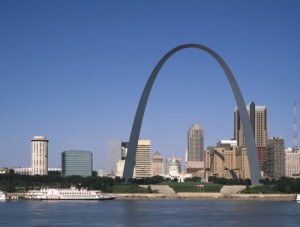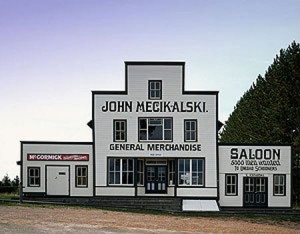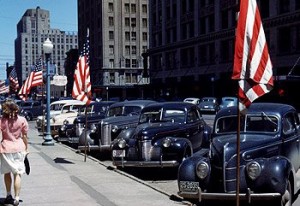A longtime colleague and friend, VOA science reporter Art Chimes, had the nerve to retire and move to St. Louis. Even though he had lots of good reasons to pick the city where a stunning Gateway Arch beckons travelers to the threshold of the American West, his decision was a bit of a shock. After all, he had grown up, gone to college and law school, and spent his entire work life until now in the hustle-bustle, dog-eat-dog, elbow-to-elbow, transient East.

If you walk westward beneath the Gateway Arch, don't think you're in the West yet. Colorado is two Midwest states away. (Carol M. Highsmith)
As a midwesterner myself, having spent my first 21 years of life in Ohio, which someone described as “that flat place between Hoboken and Malibu,” I was curious whether Art had experienced culture shock in ”Middle America.” How’s he’s adjusting, I wondered, to the place we call “the Heartland” — as much for the “heart” part as for its geographic middleness?.
Politicians trill about the Midwest’s salt-of-the-earth “small-town values”: honesty, honor, hard work, patriotism, and “God-fearing” rectitude. It’s the place, croons George Strait in his “Heartland” country-music hit, “where they still know wrong from right.”
While there are plenty of small towns elsewhere as well, the Midwest has cornered the image on white picket fences, family picnics, and rosy-cheeked newspaper delivery boys ever since Sinclair Lewis wrote the runaway bestseller Main Street in 1920.
Never mind that it was a bleak, biting satire that mocked various hypocrisies of life in fictional Gopher Prairie, Minnesota.
The title of the long-running 1950s television show “Father Knows Best” — set in a made-for-TV locale of Springfield, a leafy town in an unnamed Midwest state — says a lot about Midwest ideals. (“Springfield was a good choice. There’s one in every one of the 11 Midwest states, from Ohio to North and South Dakota.)
The show featured the Andersons: sage and patient insurance executive Jim, efficient housewife Margaret, and their 2.5 scrubbed children for whom a crisis consisted of deciding which graduation dress to wear.
OK, impish Kathy, the youngest child, was more than .5 of a person, but the perfect family package epitomized all that some saw as right, and others wrong, with the conformist Midwest. Those who mocked the idealized Anderson family later read great meaning into the revelation that off-screen, Robert Young, the actor who played the genial dad-figure, was a depressive alcoholic.
Implicit in many of the depictions of Midwest life in other than a few liberalish big cities such as Detroit and Cleveland and Minneapolis is a homogeneity of race (largely white), religion (mainstream Protestant with a few Catholics sprinkled about), outlook (positive), and politics (moderate, strongly leaning conservative).
Driving west out of densely populated Pennsylvania into Ohio, you pick up Heartland markers immediately: tidy courthouses and tinkly state fairs, Kiwanis and Rotary Club and “Welcome to Springfield” signs, the bombast of conservative radio commentator Rush Limbaugh on the radio — uninterrupted all the way to the Wyoming line (and beyond, I should note). The moment the signal of one station carrying Limbaugh’s “Excellence in Broadcasting” syndicated program fades, another takes its place.
There was no single reason why I couldn’t wait to get out of Ohio and the Midwest. Curiosity about life elsewhere after 22 years there, counting graduate-school time in Iowa, was one. What felt like an oppressive expectation to conform was another. So was an omnipresent feeling that neighbors were paying more attention to my business than their own.
If I lived there now, I’d be disillusioned about the implicit but, for so many, unfulfilled promise that prosperity — a good, long-lasting job; humble perks like a cabin at the lake, and comfortable “golden years” among friends — would reward those who played by society’s firm but unspoken rules. Ask the people whose factories and mills and agricultural co-ops have gone belly-up how that turned out.

Like cornfields and county fairs, baseball games such as this one at Chicago's venerable Wrigley Field are a fixture of Midwest life. (Carol M. Highsmith)
But lots of people find reassurance in life behind those picket fences — the church services and pot-luck suppers, soccer practice with the kids, “road trips” to a big-league ballgame in Cincinnati or Chicago — or to the geysers in Wyoming’s Yellowstone National Park. Conform, behave, raise a family in the Heartland, and life will be good.
When I left home in 1965, I was astonished to learn that more than 80 percent of the people born in Ohio — I don’t recall the exact figure — were still living there. Almost half a century later, despite Americans’ supposed wanderlust and all sorts of profound cultural changes, that number has dropped only slightly, to 77.4 percent. For the 11 Midwest states combined, the figure is 73 percent. Three out of four people never leave Middle America — or return after testing life elsewhere.
So with all that as a prelude, what does our Man in St. Louis have to say? Take it away, Heartland Art:
I know I’m supposed to have observed that people are nicer, friendlier, that they take time to get to know their neighbors, that sort of thing.
Pffft!

The Mississippi River, which cuts through the heart of the Midwest, is itself a St. Louis landmark. (kla4067, Flickr Creative Commons)
Maybe in the aggregate that is true, in that those are small-town traits, and fewer people in the Midwest live in big cities. But I moved from one big city to another, albeit one not only smaller than D.C., but losing population at a head-spinning rate. In general, people seem to have roughly similar dispositions to the ones I left behind.
With one exception. [There followed a rant about Missouri drivers, the details of which I will spare you.]
I should observe that there is much less migration, particularly long-distance and international migration, than you find in D.C. and other big coastal cities.
To be sure, there are significant ethnic enclaves here — Mexican, Bosnian, Vietnamese and other communities dot the landscape. But nothing like you see in L.A. or Miami. Also, it is not particularly common to find people moving here who have no previous ties to the area. Some do come for a job, but the economy here is not exactly booming. Others decide to stay after coming to attend one of the region’s universities, particularly the city’s largest, St. Louis University, a Jesuit school whose size echoes the city’s large Roman Catholic population, and Washington University, ranked 13 in the country by U.S. News and World Report.
But in general, St. Louisans tend to stay here (or maybe go to Chicago), and newcomers tend to arrive from smaller places nearby.

You won't see quintessential Midwest scenes like this ithe crowded East, humid South, or arid West. (Carol M. Highsmith)
When Carol and I visited little Cottonwood Falls, Kansas, many years ago, we met a lovely couple, Sonda and Gary Bruce. Sonda, who was quite a washboard player in a local jug band, even got me up on stage, scratching away on a washboard with a pick or toothbrush or something. I’m looking at the washboard, which Sonda decked out with paper Kansas sunflowers, as I write.
The Bruces now live in Branson, Missouri, once an obscure dot in the Ozark Mountains that has become a country-music and entertainment venue. When I asked for some feedback about the Heartland on the Ted Landphair’s America Facebook page, Sonda responded, effusively:
Branson has several million visitors every year [who] come to a town of now 10,000 people!!! WHY do they come here? You ask them & they say because of Branson’s moral values & family shows & honoring the vets — etc. etc. etc. That is why WE bought land in Branson in 1982 with plans of retiring here & also why we spent vacations here all the years from 1982 to when we moved here.
Branson is a “Special place” that is an example of how the Midwest people live & what is important to them!!! We don’t just honor the veterans at one time of year but each & every day of the year.

As you can tell from the photo credit, this was a shot taken at a Branson performance by a member of a visiting church group. (FirstBaptistNashville, Flickr Creative Commons)
There is not a show in Branson that is not family-friendly — about every show has someone who gives a witness of their relationship with God as part of their show. There is gospel music at about every show, & come Sunday about every theater in town has church service there also!! Need help — or stand still long in Branson — & someone will start up a conversation with you. You hear Please & thank you — & yes sir & respect is shown to all ages.
We hear from visitors from all over the USA & other countries how truly friendly & caring everyone is here, & it is right, it is true!! Family values are important to everyone in this area, every show owner . . . every business in this area!!! It is just our way of life!!! If I was offered all the money in the world & any place I could live — I would still pick Branson, Mo.!!!
In my hometown of Cleveland, we also met Susan Griffith, the delightful senior media-relations specialist at Case Western Reserve University. I asked her, too, to weigh in on Midwest life and values, and she replied:
I visualize myself driving down those country roads [of her childhood] between Monona and McGregor, Iowa…or even the backroads of Ohio.

Storm clouds gather on the Minnesota prairie. (Carol M. Highsmith)
My thought is that the Midwest is the heartland, situated in the middle of the extremes of each coastline. There is something less complicated on the plains of the Dakotas, where very few people live — and far from the congested urban areas like Chicago and Gary, Indiana. Maybe it is the wide-open space of the skies and rolling prairies and cornfields where people can actually see a horizon, and the place gives them space and a less hectic pace of life to think and realize that people close to each other and a sense of family and community are what’s important in life. Maybe it is those closer ties with the earth that creates those “Midwest values.”
But a VOA colleague whom I will not identify sought me out when she learned that I was writing about the Midwest. She has a cousin in a town of about 50,000 between Cleveland and Columbus.

Just as in 1950, when this photo was taken in Omaha, Nebraska, a lot of young people may see the bus station as representing a way out life's tedium. (Library of Congress)
Like many young people in small towns, the cousin’s son got into drugs and petty crime. My colleague attributes much of it to raging boredom that besets the aimless in places such as songwriter John Mellancamp’s “Small Town.”
All my friends are so small town.
My parents live in the same small town.
My job is so small town.
Provides little opportunity.
The song concludes:
Gonna die in this small town.
And that’s prob’ly where they’ll bury me.
Combine such a gloomy outlook with many teens’ reality — cruising and “hanging” in shopping malls that look the same in every town — and of what is there to dream, save for, as Art Chimes put it, “maybe going to Chicago”?
It fascinates me that the same things that some see as the strengths of Midwest life — “St. Louisans tend to stay here” (Art); “stand still in Branson & someone will start a conversation with you (Sonda); “the place gives [you] space and a less hectic way of life” (Susan) — are the very things that others find choking.
“The heartland lies where the heart longs to be,” Vera Nazarian wrote on her Perpetual Calendar of Inspiration. “Sometimes it takes a lifetime to find the true place to plant it.”
And sometimes it’s anywhere but the place we call the Heartland.

Artist Gary Greff depicts Midwest life along North Dakota's 'Enchanted Highway.' (Carol M. Highsmith)
Ted's Wild Words
These are a few words from this posting that you may not know. Each time, I'll tell you a little about them and also place them into a cumulative archive of "Ted's Wild Words" in the right-hand column of the home page. Just click on it there, and if there's another word that you'd like me to explain, just ask!
Rectitude. Righteousness, moral correctness, living by high-minded principles.
Trill. A pleasant, fluttering sound such as the call of a wren or other songbird.



